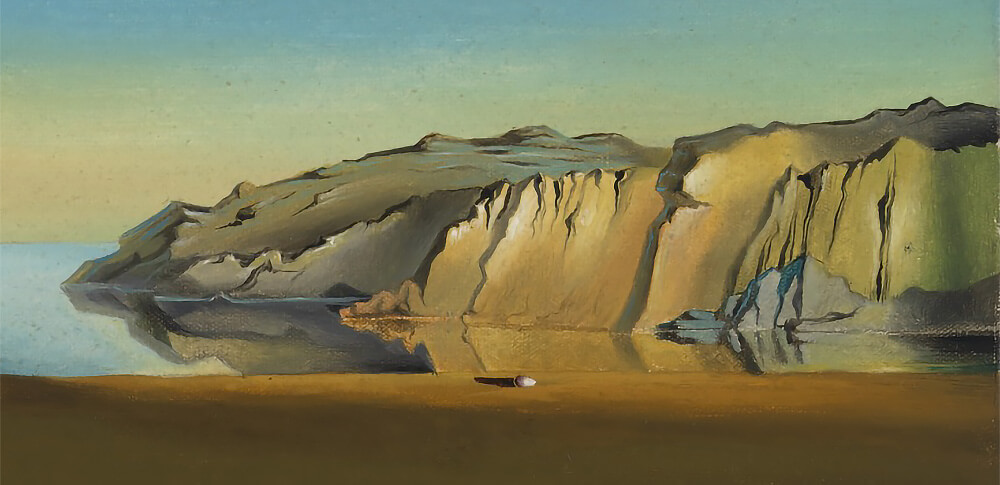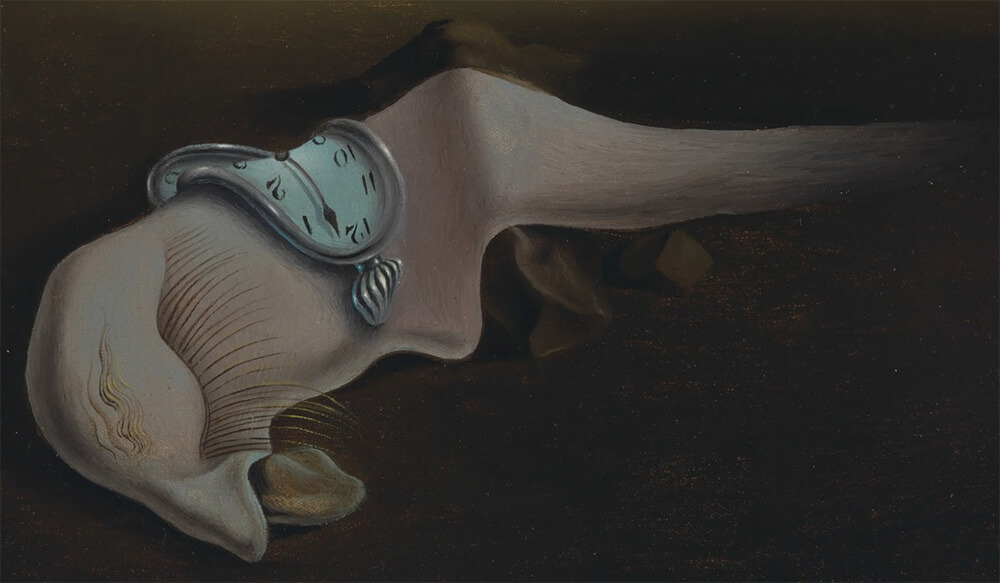Introduction
Salvador Dali’s iconic painting, The Persistence of Memory, is quite probably one of the most famous works of art in the entire world, along with Da Vinci’s Mona Lisa, Picasso’s Guernica, and a few others—and certainly, it is the most-recognizable surrealist painting ever created.
After all, whether or not you know your Braque from your Baroque, those strangely melting pocket watches are instantly recognizable. . . so much so that The Persistence of Memory is still referenced and parodied in art, literature, and popular culture, more than 80 years later.
But how did this (rather small) painting garner such widespread, global interest? What makes Dali’s imagery so different from other surrealist artists of his day, or now for that matter?
And what do those melting clocks mean?
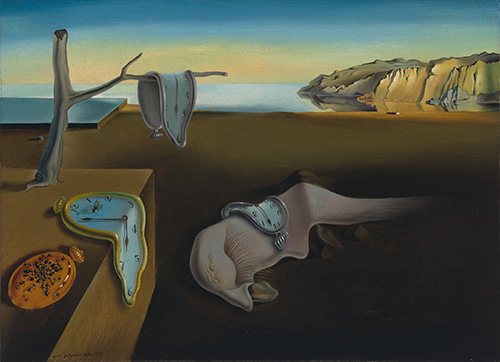
To answer all of these questions, let’s first take a short trip back to 1931, the year that The Persistence of Memory was painted.
By 1931, Salvador Dali had already attended (and been expelled from) San Fernando Academy of Art in Madrid. He was 27, and living in a recently-purchased fishing cottage in the town of Port Lligat on the Mediterranean Sea with his future wife, Gala.
It was far removed from the center of Spain—in fact, his cottage was just 25 miles south of the French/Spanish border. But Dali had already visited Paris several times, and had begun to experiment in the fledgling movement of Surrealism.
And it was here in this strange, rocky coastline that Dali would take the seeds of what he’d learned in Paris and Madrid, and craft something new—something eminently “Dali-esque.”
Later in life, Dali often spoke about his desire to confuse the viewer’s eye with hyper-realistic imagery that conveyed impossible, dreamlike scenes. Even at this comparatively young age, though, Dali wanted to force his viewers to encounter something indescribable, undefinable, unknowable. To make us wonder, even if just for a second—what is real?
To Dali, that questioning-and-yet-not-knowing is what Surrealism is all about. To others, however, it meant something a bit different.
A brief history of the Surrealist Movement
Today, the word “Surrealism” usually brings to mind the strangely fantastical paintings of Dali or Magritte, but that’s not how the movement began.
Surrealism’s founder was not an artist. His name was André Breton, and he was a writer and poet who published “The First Manifesto of Surrealism” in Paris in 1924. From the early 1920’s up until the second World War, Breton and a group of writers, artists, and activists in Paris formed the core of the Surrealist movement.
Like the members of the Dada movement before them, the Surrealists believed that logical thought was at the root of all the world’s problems. Freud’s invention of psychoanalysis and emphasis on the subconscious, dreaming mind was a large influence on their efforts to create art and literature through the use of automatic or subconscious effort, rather than logical planning.
Yet Breton wasn’t only interested in the creative aspect of Surrealism. He wanted to use it as a political movement as well—first by changing the way that people viewed the world around them, and then helping the downtrodden rise up against their oppressors.
This led to frequent rifts in the Surrealist movement, as various artists and writers connected with the creative aspect of Surrealism, but not the political.
Dali was one of the many artists who eventually distanced himself from that group in Paris—and over the next several decades, his name and fame grew even brighter than Breton’s. Today, he’s known as one of the most prolific Surrealist artists in history.
Salvador Dali’s painting methods & materials
Dali typically painted on stretched canvas or wood panel, although some of his earliest works are on cardboard as well. He often started by covering his surface with a white ground (similar to how artists today use white Gesso to prime canvas) and then painted in his horizon line, sky, and landscape.
For his important figures and subjects, he would add a highly-detailed drawing over the top of his empty landscape in black or blue pencil. He would then use small brushes, adding tiny strokes of oil paint to ensure hyper-realistic results. Using a scan of ultraviolet light, it’s also been determined that Dali (at least sometimes) mixed his oil paint with a naturally-occurring resin material, such as damar resin, to give his paint an ultra-smooth, very liquid aspect.
Read next — A Complete List of Oil Painting Supplies Every Beginner Oil Painter Needs
Dali’s earlier works were influenced by the Impressionists, as well as the realism of painters like Diego Velazquez, and the Cubism of Picasso and Braque. Like many artists, Dali learned from both his contemporaries and the rich history of art in Europe.
By the time he reached his cottage by the sea, however, his own style was emerging.
Salvador Dali’s primary inspiration was taken from Freud’s writings on the subconscious. Unlike the Surrealists who worked in “automatic” methods or used random chance to create art, Dali attempting to maintain a delusional, dreamlike state while crafting his hyper-realistic paintings. Dali coined his own term for his mental gymnastics, which he called “paranoiac critical.”
He used this method for the next 50 years to create surreal landscapes stripped down into harsh, empty stages, with strong shadows and distant horizons. He populated those worlds with fully-realized surreal figures, animals, and objects—much like players in a starkly-vivid dream you can only remember for a moment after waking.
Analysis of The Persistence of Memory
Since Dali’s intention was to use his art as a vehicle for his subconscious, we have every reason to analyze The Persistence of Memory through the lens of who Dali is—his life experiences, his desires, and his fears. With that in mind, let’s examine the 4 parts of this painting that were most important to Dali:
The landscape
With the clear blue of the Mediterranean visible from his cottage windows and the foothills of the Serra de Rodes rising behind him, it’s no surprise that The Persistence of Memory features calm water and jutting cliffs reminiscent of his new home—certainly, those distinct cliffs help link this piece with Dali himself, in a very personal way.
However, Dali primarily used this landscape as a backdrop and means of creating a clear visual space for the surreal story taking place.
For the landscape itself, only a few features emerge: a (seemingly) dead olive tree growing out of a large square platform, and another more distant platform closer to the water. The olive tree demonstrates the stunted growth and the lifeless nature of this world, while serving as a structural prop to hold up one of Dali’s melting pocket watches in the middle of the painting.
Both platforms help to balance the composition (a counterpoint to the cliffs on the right side of the painting) and bring a clear sense of perspective depth without distracting from the rest of the painting. Dali chose not to use buildings—or natural, or organic elements—to add perspective, no doubt in order to play up the “lifeless” and empty nature of this dreamlike place.
Melting clocks
Much has been made of these melting pocket watches, and rightfully so—they are unique to Salvador Dali’s work, and are the most memorable objects in this painting. When asked about them, Dali simply said they were inspired by melting cheese, but looking at Dali’s work as a whole, we can see there’s a bit more to them than that.
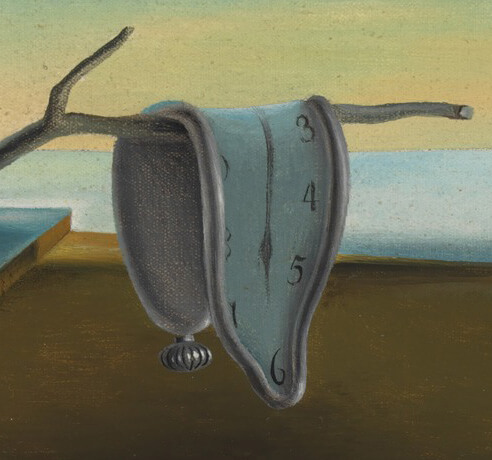
There is no doubt that time—or the concept of time, in this dreamlike place—is not functioning in a familiar, reliable way. And if time is unreliable, then what guarantees do we have that ANY element of this world acts in a logical fashion?
The short answer? There is no guarantee. No constants. Everything in this surreal world that Dali created is unknowable.
A surreal melting figure
In the center of the painting lies an even more confusing image. A figure, or creature, lies senseless on the group. The flat clock draped over its back almost feels like a saddle, but there are other interpretations as well. Perhaps the watch is weighing it down, or has merely fallen upon its prone body by happenstance.
Whatever the case, the figure DOES show some resemblance to a partial self-portrait of Dali. A nose, and perhaps a closed eye with long, antennae-like eyelashes make up the left-most side.
This may represent the tilted, dream-like experience of Dali himself in this space. The rocks beneath it serve to illustrate its fluid, melting state, much like the tree branch and platform do the same for two of the pocket watches.
Whether this is a true self-portrait or not, we may never know for sure, but it is a popular opinion given Dali’s interest in exploring his own subconscious through his art.
Congregating ants
The final important element of this painting is the cluster of ants gathering on the back of the only face-down pocket watch in the composition.
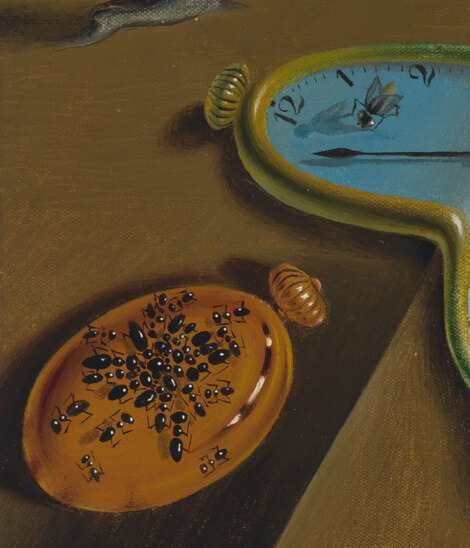
As a painter myself, I can appreciate the composition both ways—if that last pocket watch containing the ants had NOT been included in the painting, this painting would have a slightly more typical grouping of visual elements (formed by the three watches) reminiscent of classical paintings with their structured, triangular compositions.
With the fourth watch and ants included, Dali has created a sort of visual arrowhead—crafting a painting with a much more dynamic and non-traditional composition. The closeness of the fourth watch to the edge of the painting draws the eye, as does its more intense, orange, color and the contrasting black ants gathering on top of it.
There’s no reason to believe, for sure, that the fourth watch was added later—but its visual importance makes it clear that the ants (or their destructive influence, at least) hold special meaning to Dali.
Estimated value at art auction
The Persistence of Memory has never been solid at auction and was donated anonymously to the Museum of Modern Art’s collection in 1934 (where it has remained for over 80 years). Given its current owner, its importance in art history, and its cultural popularity, it is unlikely ever to be sold.
However, we can extrapolate the value of The Persistence of Memory by looking at the most expensive purchase of a Dali painting to-date, as well as sales of artwork by other modern artists.
Dali’s most expensive painting was Portrait de Paul Eluard which sold for just under 22.5 million dollars in 2011 and gives us a baseline value for The Persistence of Memory. In recent years, paintings by Jackson Pollock, Mark Rothko, and Pablo Picasso have all sold for between 100 and 200 million dollars, which offers an upper range (and perhaps a better estimate) of value. As a result, it’s likely that The Persistence of Memory would sell for anywhere from 50 to 150 million dollars.
Where is The Persistence of Memory now?
If you’re in New York City you can see The Persistence of Memory yourself by visiting The Museum of Modern Art at its mid-town Manhattan location. The full address is below:
Floor 5, Collection Galleries
The Museum of Modern Art
11 West 53 Street, Manhattan
MoMA is open seven days a week, from 10:30am-5:30pm, and until 8pm on Fridays. Admission tickets cost $25 for adults, $18 for seniors (65+), $14 for full-time students, and are free for children under 16.
Free Friday Night tickets for the general public are also available from 4pm-8pm on Friday evenings only.
Similar paintings by Salvador Dali
While many of Dali’s Surrealist paintings contain similar arid landscapes and prominent rocky cliffs, he returned to the specific landscape of The Persistence of Memory in the 1950’s, creating a secondary work titled The Disintegration of The Persistence of Memory.

The cliffs separate from the water, rising upward into the sky while pocket watches begin to float and shiver apart into the air. The olive tree separates branch from limb, limb from trunk and even the water lifts up like a sheet.
Underneath it all, a grid of blocks (referencing the new era of nuclear power and atomic weapons) seems seconds away from permanently vanishing into chaos.
Copyright information
The Persistence of Memory and The Disintegration of The Persistence of Memory are copyright © Salvador Dalí, Gala-Salvador Dalí Foundation / Artists Rights Society (ARS), New York.
Sources & further reading
The Surrealist Movement
How the Surrealist Movement Shaped the Course of Art History
The Surrealist Art Movement: André Breton, the Subconscious, and Surrealism
The Surrealist Manifesto
Salvador Dali
A Timeline of Salvador Dali’s Life
Salvador Dali, the Famous Surrealist Painter
Salvador Dalí: Spanish Painter, Sculptor, Filmmaker, Printmaker, and Performance Artist
Salvador-Dali.org
The Persistence of Memory
Official MoMA exhibit of The Persistence of Memory
The Persistence of Memory Explained
The History of The Persistence of Memory
Wikipedia & WikiArt articles
Other Articles & Resources
Salvador Dalí’s Forgotten Horizon
Oil Painting Certified as Early Work by Dali
Dali Work Still Highest Auction Price for a Work of Surrealism
The Disintegration of The Persistence of Memory
List of Most Expensive Paintings Ever Sold

